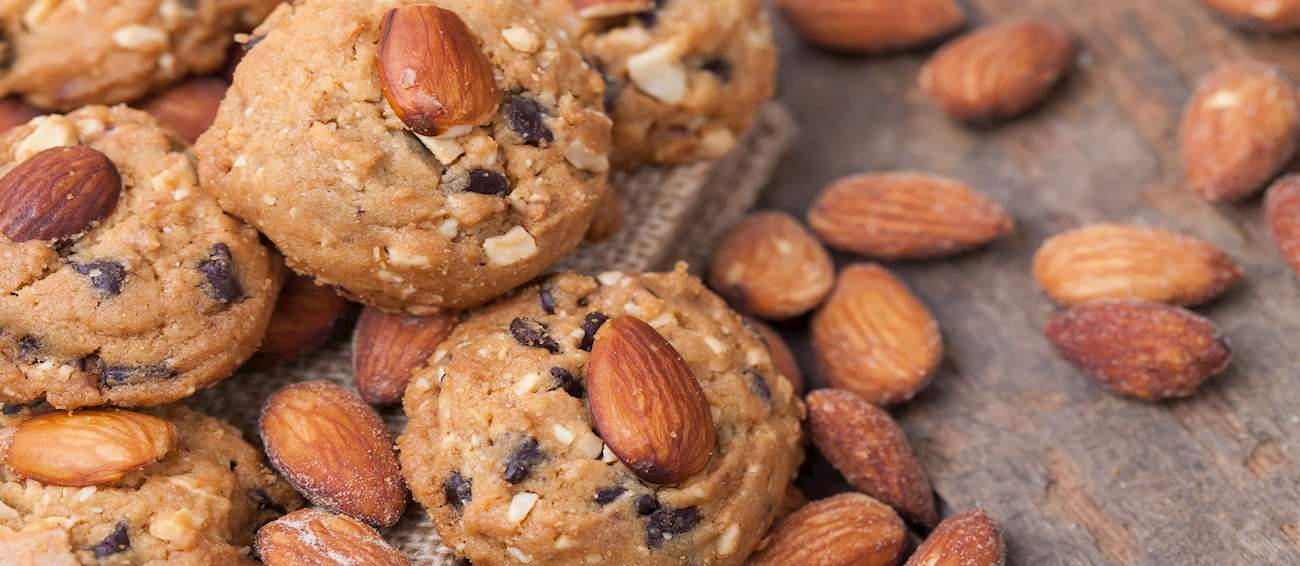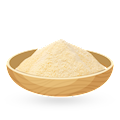Though they are thought to have originated in ancient Phoenicia, melomakaronas are nowadays a typical Greek Christmas treat. These delicious semolina cookies are traditionally flavored with honey, orange zest, cinnamon and other spices, olive oil, and cognac.
Immediately after baking, melomakarona cookies are doused in honey syrup, then sprinkled with ground walnuts. Although some argue that another Greek treat that goes under the name finikia refers to a slightly different dessert, occasionally fried and served without walnuts, today both names are used interchangeably.
MAIN INGREDIENTS
These delicate Greek cookies are prepared with ground almonds, egg whites, sugar, and various flavorings such as orange blossom water, liqueurs, or vanilla. Usually decorated with almonds or almond slivers, they come in different forms and are occasionally coupled with pastry creams.
Amygdalotá cookies are traditionally baked and enjoyed on special occasions and are often given as presents on christenings and weddings.
MAIN INGREDIENTS
These crispy and buttery shortbread cookies are a classic Greek dessert. Even though some variations occasionally employ walnuts, they are traditionally prepared with a rich dough that incorporates ground almonds, butter, and various flavorings such as vanilla or strong brandy.
They are usually shaped into crescent or round shapes and are generously coated in powdered sugar. Traditionally associated with festive occasions, kourabiedes are a staple Christmas cookie, but they are also associated with Easter and many other special occasions.
MAIN INGREDIENTS
The star ingredient in these chewy, soft cookies is grape must or petimezi, a syrup-like grape molasses. It is blended into a pliable dough that combines sugar or honey, flour, leavening agent, orange juice, and spices such as cinnamon and cloves.
The dough is traditionally shaped into thin rolls that are then swirled into medium-sized round cookies. Since grape must is an autumnal product, the cookies are usually enjoyed throughout autumn and winter. Their flavor is reminiscent of gingerbread, and they are best paired with a cup of coffee or tea.
MAIN INGREDIENTS
Mamoulia are festive Greek cookies that have been traditionally prepared on the island of Chios, although they are also commonly eaten on other Greek islands. To make the cookies, a dough of flour, butter, fresh milk, sugar, eggs, olive oil, baking soda, baking powder, and brandy is shaped into small balls which are stuffed with a mixture of finely chopped nuts.
The filling typically consists of almonds, walnuts, pistachios, and confectioners' sugar, and it is usually flavored with flower water, cinnamon, cloves, and nutmeg. The cookies often take the shape of a pear, and once baked, they are typically sprinkled with flower water and coated with confectioners' sugar before serving.
MAIN INGREDIENTS
Paximathakia is the Greek version of biscotti. The cookies are made with a combination of flour, baking soda, orange juice, lemon juice and peel, olive oil, cinnamon, toasted sesame seeds, sugar, and baking powder. The sticky dough is shaped into logs that are baked until firm, cut into slices, then baked again at a lower temperature, which will draw the moisture out of the cookies.
These twice baked cookies should be left to cool completely before they're stored in airtight containers.
MAIN INGREDIENTS
These classic Cretan cookies combine flaky dough with a sweet nut-based filling. The pastry dough is made with bicarbonate of soda (ammonia), while the filling mainly consists of nuts such as almonds or walnuts, sesame seeds, and spices such as cinnamon and nutmeg.
The cookies are traditionally shaped into half-moons, then generously dusted with powdered sugar. Patouda cookies are best paired with a cup of strong coffee.
TasteAtlas food rankings are based on the ratings of the TasteAtlas audience, with a series of mechanisms that recognize real users and that ignore bot, nationalist or local patriotic ratings, and give additional value to the ratings of users that the system recognizes as knowledgeable. TasteAtlas Rankings should not be seen as the final global conclusion about food. Their purpose is to promote excellent local foods, instill pride in traditional dishes, and arouse curiosity about dishes you haven’t tried.












